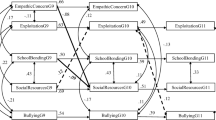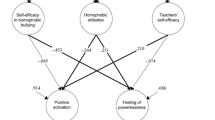Abstract
The purpose of the present study was to examine the relationship between bullying, victimization and a number of social-emotional variables such as trait emotional intelligence, empathy and self-efficacy in 206 elementary school 6th graders in Greece. Results indicated that boys reported significantly more direct and indirect bullying behaviors than girls, and higher victimization. Bullying was negatively correlated with overall self-efficacy and its academic component, trait emotional intelligence, empathy and its cognitive component, while victimization was negatively correlated with overall self-efficacy and its three dimensions, trait emotional intelligence, affective and cognitive empathy. Gender, trait emotional intelligence, and cognitive empathy significantly predicted bullying, whereas victimization was predicted by gender, trait emotional intelligence and affective empathy.
Similar content being viewed by others
References
Andreou E. (2004) Bully/victim problems and their association with machiavellianism and self-efficacy in Greek primary school children. British Journal of Educational Psychology 74: 297–309
Andreou E., Metallidou P. (2004) The relationship of academic and social cognition in behavior in bullying situations among Greek primary school children. Educational Psychology 24: 27–41
Arsenio W. F., Lemerise E. A. (2001) Varieties of childhood bullying: Values, emotion processes and social competence. Social Development 10: 59–73
Arora C. M. J., Thompson D. A. (1987) Defining bullying for a secondary school. Educational and Child Psychology 4: 110–120
Austin E. J., Saklofske D. H., Egan V. (2005) Personality, well-being and health correlates of trait emotional intelligence. Personality and Individual Difference 38: 547–558
Bandura A. (1977) Social learning theory. Prentice Hall, Englewood Cliffs, NJ
Bandura A. (1997) Self-efficacy: The exercise of control. Freeman, New York
Bandura A. (1999) Social cognitive theory of personality. In: Pervin L. A., John O. P (eds) Handbook of personality (2nd ed.). Guilford, New York, pp 154–196
Bjorkqvist K., Lagerspetz K. M. J., Kaukiainen A. (1992) Do girls manipulate and boys fight? Developmental trends in regard to direct and indirect aggression. Aggressive Behavior 18: 117–127
Bronson M. B. (2000) Recognizing and supporting the development of self-regulation in young children. Young Children 55: 32–37
Caprara G. V., Barbaranelli C., Pastorelli C., Cervone D. (2004) The contribution of self-efficacy beliefs to psychological outcomes in adolescence: Predicting beyond global dispositional tendencies. Personality and Individual Differences 37: 751–763
Champion K., Vernberg E., Shipman K. (2003) Nonbullying victims of bullies: Aggression, social skills, and friendship characteristics. Applied Developmental Psychology 24: 535–551
Ciarrochi J. V., Chan A. Y. C., Bajgar J. (2001) Measuring emotional intelligence in adolescents. Personality and Individual Differences 31: 1105–1119
Crick N. R., Grotpeter J. K. (1995) Relational aggression, gender, and social-psychological adjustment. Child Development 66: 710–722
Davis M. H. (1980) A multidimensional approach to individual differences in empathy. JSAS Catalog of Selected Documents in Psychology 10: 85
Davis M. H. (1994) Empathy, a social psychological approach. Wm. Brown C. Communications Inc, USA
Erath S. A., Flanagan K. S., Bierman K. L., Tu K. M. (2010) Friendships moderate psychosocial maladjustment in socially anxious early adolescents. Journal of Applied Developmental Psychology 31: 15–26
Garner P. W., Lemerise E. A. (2007) The roles of behavioral adjustment and conceptions of peers and emotions in preschool children’s peer victimization. Development and Psychopathology 19: 57–71
Garton A., Gringart E. (2005) The development of a scale to measure empathy in 8- and 9-year old children. The Australian Journal of Educational and Developmental Psychology 5: 17–25
Gini G., Albiero P., Benelli B., Altoe G. (2007) Does empathy predict adolescents’ bullying and defending behavior?. Aggressive Behavior 33: 1–10
Goleman D. (1995) Emotional intelligence: Why it can matter more than IQ. Bantam, New York
Griffin R. S., Gross M. A. (2004) Childhood bullying: Current empirical findings and future directions for research. Aggression and Violent behavior 9: 379–400
Harter S. (1990) Causes, correlates, and the functional role of global self-worth: A life-span perspective. In: Sternberg R.J., Kolligian J. (eds) Competence considered. Yale University Press, New Haven, CT, pp 67–97
Hogan R. (1969) Development of an empathy scale. Journal of Consulting Clinical Psychology 33: 307–316
Houndoumadi A., Pateraki L. (2001) Bullying and bullies in Greek elementary schools: Pupils’ attitudes and teachers’/parents’ awareness. Educational Review 53: 19–26
Jolliffe D., Farrington D. P. (2004) Empathy and offending: A systematic review and meta-analysis. Aggression and Violent Behavior 9: 441–476
Jolliffe D., Farrington D. P. (2006) Examining the relationship between low empathy and bullying. Aggressive Behavior 32: 540–550
Kaukiainen A., Bjorkqvist K., Lagerspetz K. M. J., Osterman K., Salmivalli C., Forsblom S. et al (1999) The relationships between social intelligence, empathy, and three types of aggression. Aggressive Behavior 25: 81–89
Keltikangas-Jarvinen L., Pakasiahti L. (1999) Development of social problem solving strategies and changes in aggressive behavior: A 7-year follow-up from childhood to late adolescence. Aggressive Behavior 25: 269–279
Kerig P. K. (2007) Understanding youth aggression. New Research in Mental Health 18: 88–101
Kokkinos, C. M. & Logginidou, E. (2005). Perceived parental rearing behaviors among elementary school children involved in bullying and victimization. Paper presented at the 27th international school psychology association (ISPA) colloquium, Athens, 13-17/7 2005.
Kokkinos C. M. (2007) Elementary school children’s involvement in bullying and victimization: The role of attachment style and internalizing and externalizing symptomatology. Scientia Paedagogica Experimentalis XLIV 1: 33–49
Kokkinos C. M., Panayiotou G. (2004) Predicting bullying and victimization among early adolescents: Associations with disruptive behavior disorders. Aggressive Behavior 30: 520–533
Ladd G. W. (2005) Children’s peer relations and social competence. Yale University Press, New Haven
Limber S. P., Nation M., Tracy A. J., Melton G. B., Vlerx V. (2004) Of the Olweus bullying prevention program in the Southeastern United States. In: Smith P. K., Pepler D., Rigby K. (eds) Bullying in schools: How successful can interventions be?. Cambridge University Press, Cambridge, pp 55–79
Malti T., Gummerum M., Keller M., Buchmann M. (2009) Children’s moral motivation, sympathy, and prosocial behavior. Child Development 80: 442–460
Malti T., Perren S., Buchmann M. (2010) Children’s peer victimization, empathy, and emotional symptoms. Child Psychiatry of Human Development 41: 98–113
Mavroveli S., Petrides K.V., Rieffe C., Bakker F. (2007) Trait emotional intelligence, psychological well-being, and peer-rated social competence in adolescence. British Journal of Developmental Psychology 25: 263–275
Mavroveli S., Petrides K. V., Sangareau Y., Furnham A. (2009) Exploring the relationships between trait emotional intelligence and objective socio-emotional outcomes in childhood. British Journal of Educational Psychology 79: 259–272
Mavroveli S., Sánchez-Ruiz M. J. (2011) Trait emotional intelligence influences on academic achievement and school behavior. British Journal of Educational Psychology 81: 112–134
Mehrabian A., Epstein N. (1972) A measure of emotional empathy. Journal of Personality 40: 525–543
Muris P. (2001) A brief questionnaire for measuring self-efficacy in children with affective problems. Journal of Psychopathology and behavioral Assessment 23: 145–149
Muris P. (2002) Relationships between self-efficacy and symptoms of anxiety disorders and depression in a normal adolescent sample. Personality and Individual Differences, 32: 337–348
Nansel T. R., Overpeck M. D., Pilla R. S., Ruan W. J., Simons-Morton B., Scheidt P. (2001) Bullying behavior among U.S. youth: Prevalence and association with psychosocial adjustment. Journal of the American Medical Association 285: 2094–2100
Natwig G. K., Albrektsen G., Qvarnstrom U. (2001) School-related stress experience as a risk factor for bullying behavior. Journal of Youth and Adolescence 30: 561–575
Olweus D. (1978) Aggression in the schools bullies and whipping boys. Hemisphere Press, Washington
Olweus D. (1993) Bullying in schools: What we know and what we can do. Blackwell, Oxford
Olweus D. (1994) Annotation: Bullying at school: Basic facts and effects of a school based intervention program. Journal of Child Psychology and Psychiatry 35: 1171–1190
Olweus D. (1997) Bully/Victim problems in school: Facts and intervention. European Journal of Psychology of Education 12: 495–510
Pakaslahti L., Asplund-Peltola R. L., Keltikangas-Jarvinen L. (1996) Parents’ social problem-solving strategies in families with aggressive and non-aggressive boys. Aggressive behavior 22: 345–356
Petrides K. V., Frederickson N., Furnham A. (2004) The role of trait emotional intelligence in academic performance and deviant behavior at school. Personality and Individual Differences 36: 277–293
Petrides K. V., Pita R., Kokkinaki F. (2007) The location of trait emotional intelligence in personality factor space. British Journal of Psychology 98: 273–289
Petrides K. V., Sangareau Y., Furnham A., Frederickson N. (2006) Trait emotional intelligence and children’s peer relations at school. Social Development 15: 537–547
Rigby K., Slee P. (1993) Dimensions of interpersonal relating among Australian school children: Implications for psychological well-being. Journal of Social Psychology 131: 615–627
Salmivalli C., Isaacs J. (2005) Prospective relations among victimization, rejection, friendlessness, and children’s self- and peer-perceptions. Child Development 76: 1161–1171
Salmivalli C., Lagerspetz K., Bjorkqvist K., Kaukiainen K., Kaukiainen A. (1996) Bullying as a group process: Participant role and their relations to social status within the group. Aggressive Behavior 22: 1–15
Sutton J., Smith P. K., Swettenham J. (1999) Social cognition and bullying: Social inadequacy or skilled manipulation?. British Journal of Developmental Psychology 17: 435–450
Warden D., Mackinnon S. (2003) Prosocial children, bullies and victims: An investigation of their sociometric status, empathy, and social problem-solving strategies. British Journal of Developmental Psychology 21: 367–385
Wentzel K. R. (1991) Social competence at school: Relations between social responsibility and academic achievement. Review of Educational Research 61: 1–24
Wentzel K. R., Caldwell K. (1998) Friendships, peer acceptance and group membership: Relations to academic achievement in middle school. Child Development 68: 1198–1209
Author information
Authors and Affiliations
Corresponding author
Rights and permissions
About this article
Cite this article
Kokkinos, C.M., Kipritsi, E. The relationship between bullying, victimization, trait emotional intelligence, self-efficacy and empathy among preadolescents. Soc Psychol Educ 15, 41–58 (2012). https://doi.org/10.1007/s11218-011-9168-9
Received:
Accepted:
Published:
Issue Date:
DOI: https://doi.org/10.1007/s11218-011-9168-9




